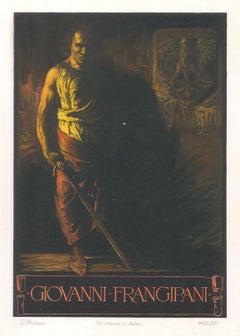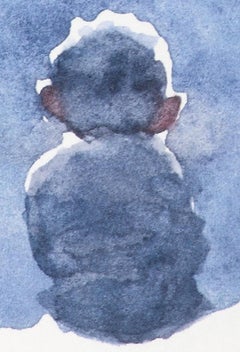Giuseppe Palanti Prints and Multiples
to
1
Overall Width
to
Overall Height
to
1
1,183
939
885
817
1
1
1
1
1
1
1
1
1
Artist: Giuseppe Palanti
Giovanni Frangipani - Vintage Advertising Lithograph by G. Palanti - 1900 ca.
By Giuseppe Palanti
Located in Roma, IT
Giovanni Frangipani is a beautiful colored lithographed original manifesto on cardboard, realized around the first years of the XX century by the Italian artist Giuseppe Palanti. Pr...
Category
Early 1900s Giuseppe Palanti Prints and Multiples
Materials
Lithograph
Related Items
Starry Night - Limited Edition, Figurative, Contemporary, Star, Night, Child
By Charlie Mackesy
Located in Knowle Lane, Cranleigh
Starry Night is a lithograph based on a watercolour by Charlie Mackesy. The edition is limited to 150 and each piece has been signed by Charlie Mackesy...
Category
2010s Other Art Style Giuseppe Palanti Prints and Multiples
Materials
Lithograph
$3,351
H 11.82 in W 7.88 in D 0.4 in
Hand of Africa - Mandela, Former South African President, Signed Artwork, Hand
By Nelson Mandela
Located in Knowle Lane, Cranleigh
Nelson Mandela, Hand of Africa, Signed Limited Edition Lithograph
Many people are unaware that Nelson Mandela turned his hand to art in his 80's as a way of leaving a legacy for his ...
Category
Early 2000s Contemporary Giuseppe Palanti Prints and Multiples
Materials
Lithograph
$20,131
H 25.5 in W 20 in D 2 in
René Magritte - LE DOMAINE D'ARNHEIM Limited Surrealism French Contemporary
By (after) René Magritte
Located in Madrid, Madrid
René Magritte - LE DOMAINE D'ARNHEIM, 1962 (THE DOMAIN OF ARNHEIM)
Date of creation: 2010
Medium: Lithograph on BFK Rives Paper
Edition number: 155/275
Size: 60 x 45 cm
Condition: Ne...
Category
Mid-20th Century Surrealist Giuseppe Palanti Prints and Multiples
Materials
Paper, Lithograph
$1,179
H 23.63 in W 17.72 in
TAKASHI MURAKAMI DOB & Me On the Red... Hand signed & numbered Superflat Pop Art
By Takashi Murakami
Located in Madrid, Madrid
DOB & Me: On the Red Mound of the Dead
Date of creation: 2013
Medium: Offset lithograph with silver on paper
Edition: 300
Size: 50 x 50 cm
Condition: In mint conditions and not frame...
Category
2010s Pop Art Giuseppe Palanti Prints and Multiples
Materials
Lithograph, Varnish, Offset
$2,962
H 19.69 in W 19.69 in
RENÉ MAGRITTE LA GRANDE FAMILLE, 1963 Limited edition Lithograph - Surrealism
By (after) René Magritte
Located in Madrid, Madrid
LA GRANDE FAMILLE, 1963 (THE LARGE FAMILY)
Date of creation: 2010
Medium: Lithograph on BFK Rives Paper
Edition: 275
Size: 60 x 45 cm
Observations: Lithograph on BFK Rives paper plat...
Category
Mid-20th Century Surrealist Giuseppe Palanti Prints and Multiples
Materials
Lithograph
$1,179
H 23.63 in W 17.72 in D 0.08 in
TAKASHI MURAKAMI: And Then x 727 (Vermillion SHU) Hand signed Superflat, Pop Art
By Takashi Murakami
Located in Madrid, Madrid
And Then x 727 (Vermillion SHU)
Date of creation: 2013
Medium: Offset lithograph with silver
Media: Paper
Edition: 300
Size: 50 x 50 cm
Observations: And Then x 727 (Vermillion SHU) ...
Category
2010s Pop Art Giuseppe Palanti Prints and Multiples
Materials
Varnish, Lithograph, Offset
$3,853
H 19.69 in W 19.69 in
RENÉ MAGRITTE L'EMPIRE DES LUMIÈRES, 1964 Limited edition Lithograph, Surrealism
By (after) René Magritte
Located in Madrid, Madrid
L'EMPIRE DES LUMIÈRES, 1964 (THE EMPIRE OF LIGHTS, 1964)
Date of creation: 2010
Medium: Lithograph on BFK Rives Paper
Edition: 275
Size: 60 x 45 cm
Observations: Lithograph on BFK Ri...
Category
Mid-20th Century Surrealist Giuseppe Palanti Prints and Multiples
Materials
Lithograph
$1,179
H 23.63 in W 17.72 in D 0.08 in
RENÉ MAGRITTE: LA MAGIE NOIRE, 1945 - Limited edition Lithograph Surrealism
By (after) René Magritte
Located in Madrid, Madrid
LA MAGIE NOIRE, 1945 (BLACK MAGIC)
Date of creation: 2010
Medium: Lithograph on BFK Rives Paper
Edition: 275
Size: 60 x 45 cm
Observations: Lithograph on BFK Rives paper plate signed...
Category
Mid-20th Century Surrealist Giuseppe Palanti Prints and Multiples
Materials
Lithograph
$1,181
H 17.72 in W 23.63 in
TAKASHI MURAKAMI: Homage to Francis Bacon. Pop Art, Superflat, Japanese Modern
By Takashi Murakami
Located in Madrid, Madrid
Homage to Francis Bacon (Study of Isabel Rawsthorne)
Date of creation: 2017
Medium: Offset lithograph with cold stamp on paper
Edition: 300
Size: 68 x 68 cm
Condition: In mint condit...
Category
2010s Pop Art Giuseppe Palanti Prints and Multiples
Materials
Paper, Lithograph, Offset
Takashi MurakamiTAKASHI MURAKAMI: Homage to Francis Bacon. Pop Art, Superflat, Japanese Modern, 2017
$4,736
H 26.78 in W 26.78 in
TAKASHI MURAKAMI DOB & Me On the Red... Hand signed & numbered Superflat Pop Art
By Takashi Murakami
Located in Madrid, Madrid
TAKASHI MURAKAMI - Time Bokan Black
Date of creation: 2011
Medium: Offset lithograph with silver on paper
Edition: 300
Size: 50 x 50 cm
Condition: In mint conditions and not framed
O...
Category
2010s Pop Art Giuseppe Palanti Prints and Multiples
Materials
Varnish, Lithograph, Offset
$3,146
H 19.69 in W 19.69 in
TAKASHI MURAKAMI: And Then x6 (Blue) Hand signed & numb. Superflat, Pop Art
By Takashi Murakami
Located in Madrid, Madrid
And Then x 6 (Blue: The Polke Method)
Date of creation: 2015
Medium: Offset lithograph with silver
Media: Paper
Edition: 300
Size: 50 x 50 cm
Observations: Offset lithograph with sil...
Category
2010s Pop Art Giuseppe Palanti Prints and Multiples
Materials
Varnish, Lithograph, Offset
$3,853
H 19.69 in W 19.69 in
TAKASHI MURAKAMI A RETURN FROM WANDERING Pop Art, Japanese Flowers Silver Black
By Takashi Murakami
Located in Madrid, Madrid
Takashi Murakami - A RETURN FROM WANDERING
Date of creation: 2022
Medium: Offset lithograph with cold stamp and high gloss varnish on paper
Edition: 300
Size: 71 cm Ø
Condition: In m...
Category
2010s Pop Art Giuseppe Palanti Prints and Multiples
Materials
Paper, Varnish, Lithograph, Offset
$4,743
H 27.96 in Dm 27.96 in
Giuseppe Palanti prints and multiples for sale on 1stDibs.
Find a wide variety of authentic Giuseppe Palanti prints and multiples available for sale on 1stDibs. You can also browse by medium to find art by Giuseppe Palanti in lithograph and more. Not every interior allows for large Giuseppe Palanti prints and multiples, so small editions measuring 11 inches across are available. Customers who are interested in this artist might also find the work of Leopoldo Metlicovitz, Aleardo Terzi, and Giovanni Guerrini. Giuseppe Palanti prints and multiples prices can differ depending upon medium, time period and other attributes. On 1stDibs, the price for these items starts at $896 and tops out at $896, while the average work can sell for $896.


